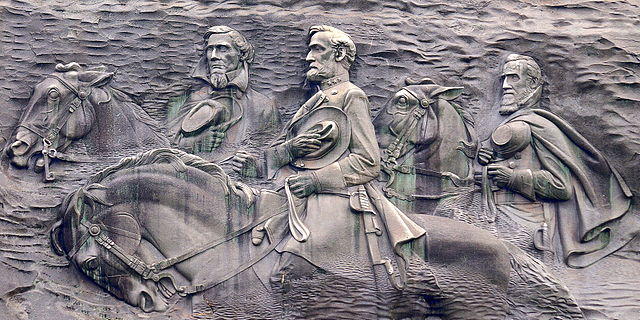
Section Branding
Header Content
The True History of Stone Mountain
Primary Content
A new documentary from the Atlanta History Center about the history of Stone Mountain, and the memorial to the Confederacy carved into its flank, has prompted many Georgians to re-examine what they thought they knew about the carving and how it got there. It also prompted a story in Chuck Reece’s online magazine, Salvation South. Chuck has details in this week's commentary.

TRANSCRIPT:
Chuck Reece: I wish I had a dollar for every time this has happened to me: I drive by a spot in my neighborhood and see new construction going up, and I cannot for the life of me remember what was there before. We see things every day, but we don’t always see them. We don’t think about what purpose they serve, who they belong to, or why they were put there in the first place.
This happened to my writer friend Doug Cumming after he retired from his university teaching job in Virginia and moved home to Decatur. He drove into town from the east on Highway 78, which takes you right by Stone Mountain. It looms high on the horizon. And Doug remembered how he and his friends thought about Stone Mountain when they were growing up. This is how he described it in a story he wrote for Salvation South, the online magazine I edit.
“To us who grew up in the Atlanta of the 1960s, [Stone Mountain] was a shabby theme park with a train, picnic tables and a gondola ride. It was just a crowded Georgia State Park, ‘the world’s largest granite outcropping’ with a grandiose chiseling project somewhere on its flanks.”
That chiseling project, of course, is the world’s largest memorial to the Confederacy — the army of Southern states that rebelled against the U.S. government in pursuit of a central aim: to continue the horrible institution of slavery.
Doug wanted to learn the genuine history of how and why that memorial was carved into the granite. He didn’t know it, but the Atlanta History Center was already hard at work on a half-hour documentary film about that story, and Doug went to its debut in January.
Now many Georgians have gone most of their lives thinking that carving has just always been on Stone Mountain. The carving project did begin a hundred years ago, a private endeavor funded by the United Daughters of the Confederacy, the same ladies who persistently perpetuated the myth of the Lost Cause — the false version of history that claims the Confederates fought for causes more noble than the maintenance of slavery. But the Daughters ran out of money, and only an unfinished carving of Robert E. Lee was left. The project was not resurrected until the late 1950s, at the command of our state government, led by a segregationist governor, Marvin Griffin, and legislators who were incensed when the U.S. Supreme Court declared that segregation in public schools was unconstitutional.
I don’t have enough time with you today to walk through the complete history. But I encourage you to watch the Atlanta History Center’s documentary and to read stories like Doug Cumming’s that reveal the truth about Stone Mountain. We might all be familiar with that giant rock and the carving on its side, but too few of us have actually seen it — and learned what it means and why it was put there.
Come visit us at SalvationSouth.com.
Salvation South editor Chuck Reece comments on Southern culture and values in a weekly segment that airs Fridays at 7:45 a.m. during Morning Edition and 4:44 p.m. during All Things Considered on GPB Radio. You can also find them here at GPB.org/Salvation-South and please download and subscribe on your favorite podcast platform as well.






